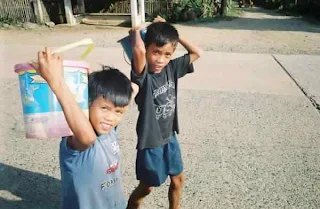Some 15 years ago, when I was working for Plan International Bicol, gathering information from the NGO’s beneficiaries respondents in the upland barangays surrounding Mount Isarog and the Bicol National Park, I carried a notebook where I wrote verses for my mother Emma, who passed away in January 1996.
For Emma, who loved so much
Tomorrow I will build a house
by the forest near the sea
where six palm trees will become
and warm candles by night.
At the time, I kept a journal wherever I went—perhaps to relive the days with my mother whom I dearly lost during her life [I hardly had time for her when she was sick] and tearfully loved after her death [after college graduation, there was not much to do aside from job-hunting and freelancing]. And there was not much reason to hunt for jobs at all because there would be no one to offer my first salary.
Pride, Not Prejudice
After so many versions and revisions, a national magazine then edited by the National Artist for Literature Nick Joaquin—published a longer submission (see below) before the end of the year. The publication of my poem in Philippine Graphic Weekly thrilled me to no end. I felt too lucky to have my [too personal a] sentiment printed in a national publication.
With this, the tribute to my mother was heightened. For one, she would have loved to see my work printed on a national paper. Sad to say, though, it is my contemplation on her death that would give [her or me] such pride.
The Sea House
Philippine Graphic Weekly
November 1996
I hate to leave really.
But I should go home tonight.
Tomorrow I will build a house
by the forest near the sea
where I alone can hear my silence.
For it, I gathered six palm trees
stronger than me, to become
the pillars, firm foundations
of my tranquil days to come
about which I will not anymore hear.
I know the trees are good
for they survived many typhoons
in the past that uprooted many others
and which made others bend, and die.
I hope they become bright lamps
along the road where I will pass
when I go home tonight.
I hope they’d be there and that
they would recognize me.
And if they don’t, it wouldn’t matter.
I would not want any trees
other than them.
For I know they are very good.
But tonight, please let them be
my warm candles.
And when I’m home I will be certain:
Tomorrow, I will have built a house
in the forest near the sea where
Every palm tree can hear silence.
And the others can listen.
Reader’s Response
Finding the poem in one of my diskette files when I applied for work in Quezon City and Manila, my brother Mente—perhaps to while away his time—translated it to Bikol, rendering a rather old, Bikol archaic version.
An Harong Sa May Dagat
(Para qui Emma, na sobrang namoot)
1997
Magabat an boot co na maghale,
Alagad caipuhan co na mag-uli
Ngonyan na banggui.
Sa aga, matugdoc aco nin harong
Sa cadlagan harani sa dagat,
Cun sain aco na sana an macacadangog
Can sacuyang catranquiluhan.
Sa palibot caini, matanom aco
Nin anom na poon nin niyog
Na mas masarig sa saco,
Na magiging mga harigi—
Manga pusog na pundasyon
Can manga matuninong cong aldaw
Na dae co naman madadangog.
Ma’wot co na sinda magserbing
Maliwanag na ilaw sa dalan
Sa macangirhat na diclom,
Cun sain aco ma-agui
Sa sacuyang pag-uli
Ngonyan na banggui.
Ma’wot co man na yaon sinda duman
Asin na aco mamidbid ninda.
Alagad cun sinda malingaw saco,
Dae na bale.
Nungca na aco mahanap
Nin caribay ninda, nin huli ta aram co
Na sinda mga marhay.
Alagad atyan na banggui,
Hahagadon co na sinda
Magserbing mga maiimbong
Na candila cataid co.
Asin cun aco naca-uli na
Sigurado aco na sa aga
Iguwa na aco nin harong
Sa cadlagan harani sa dagat
Cun sain aco na sana
An macacadangog
Can sacuyang catranquiluhan.
Asin an iba macacadangog.
My Brother, My ExecutionerPerhaps having the spirit of the classicists who dearly loved the classical age before them, reinventing an old manuscript to serve their own purposes, Mente made an English version based on his English translation.
Wanting to relive for himself the memory of our dear mother, Mente turned in his own masterpiece based on the published poem. Notice how the versification has radically changed—from irregular free verses to a series of couplets—and ending with a one-liner which is supposed to be the poem’s closure.
In the process, the version he rendered would become totally his original work. Comparing his piece with the original published piece, I see that the new work now brims with new meanings and warrants a different, if not disparate interpretation.
The House by The Sea
(For Emma, who Loved So Much)
1997
I leave with a heavy heart
But I need to go home tonight.
Tomorrow, I’ll build a house by the sea,
Where only I will hear my tranquility.
Around it I’ll plant six coconut trees
Which are stronger than I am.
Trees that will become the stable foundation
of my quiet days, which I will no longer hear.
Undoubtedly, these coconut trees are the best
Because they have overcome many storms, that uprooted the others.
I want them to light the way through horrible darkness,
Where I will pass when I go home tonight.
I like them to be there and for them to know me
But it wouldnt matter if they’ve forgotten me.
Nobody can replace them
Because I know they are good.
But tonight I’ll ask them to be like candles,
Warm, beside me. And when I am home
I will have surely built a house by the sea
Where only I will hear my tranquility.
And others will hear it, too.
A Promise to Write (A Poem)
After having undergone a number of literary workshops, I realize that images, symbols and metaphors [if any if at all] I used in the first draft were confusing and too overwhelming—giving it a puzzling dramatic situation.
Now, I realize that the poem published in the past and wholly appreciated by my dear brother—with my sister perhaps, my sole readers at the time—carried double and mixed metaphors which rendered the piece fragmented, incoherent and totally not a good poem at all.
And perhaps because it was dedicated to my dear mother, I never subjected this piece to any workshop. I submitted other pieces, and not this one. Perhaps because I considered the work too sacred to be desecrated, or more aptly, slaughtered by the write people.
Nothing writes so much as blood;
the rest are mere strangers.—corrupted from Lawrence Kasdan’s Wyatt Earp, 1994













